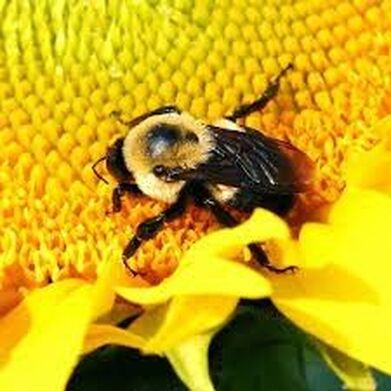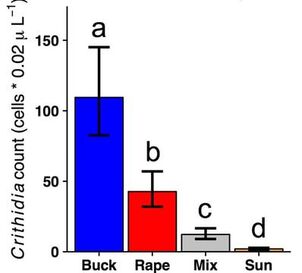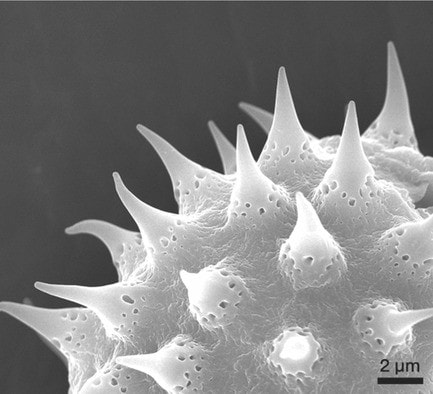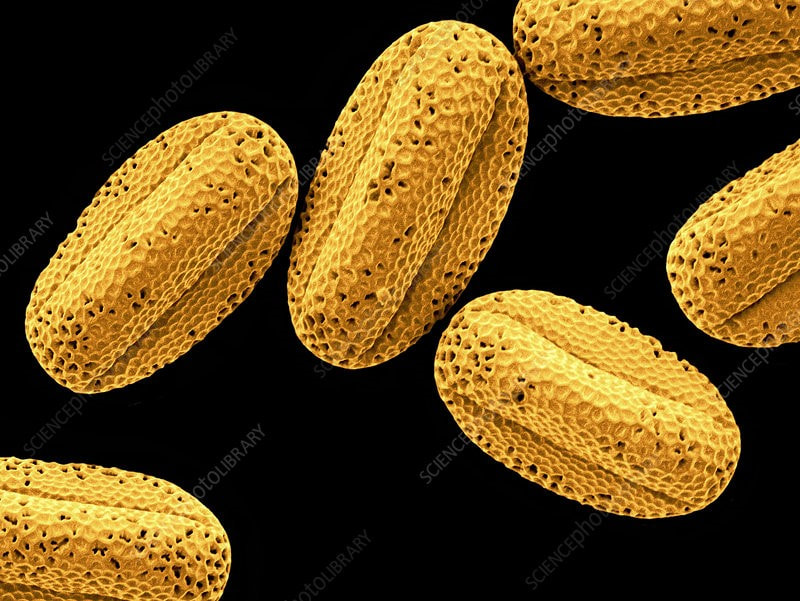 Figure 1. Common eastern bumblebee (Bombus impatiens) on sunflower (Helianthus annuus). Arrow refers to the black patch that distinguishes B. impatiens from other bee species. Images from: Gary B at https://www.jungledragon.com/image/75741/bombus_impatiens_and_sunflower.html Figure 1. Common eastern bumblebee (Bombus impatiens) on sunflower (Helianthus annuus). Arrow refers to the black patch that distinguishes B. impatiens from other bee species. Images from: Gary B at https://www.jungledragon.com/image/75741/bombus_impatiens_and_sunflower.html In a recent seminar for the UMD Entomology department, Dr. Adler discussed her work on the role of plants in mediating interactions between bumblebees and pathogens. She posed a series of questions: Does sunflower pollen act as a “medicine” that can help bumblebees fend off disease? How effective is it? What is the mechanism driving resistance? Dr. Adler's work primarily focuses on the interactions between the common eastern bumblebee (Bombus impatiens, B. impatiens), the sunflower (Helianthus annus, H. annuus), and the gut parasite, Crithidia bombi (Crithidia). B. impatiens is the most common bumblebee species in the Eastern United States; it can be primarily distinguished from other bumblebees by a large, shiny black spot on its back (Fig. 1). Unlike other bee species which have declining populations, B. impatiens has a stable population level. Therefore, using this species as a model organism allows Dr. Adler to test questions about pollinator health without directly impacting bee species already in decline. Crithidia is transmitted from bee to bee through ingestion of the fecal matter of infected bees. Crithidia can reduce the lifespan of worker bees and queens, threatening colony survival. In other words, poop transmission!  Figure 2. When B. impatiens were fed pollen diets from sunflowers, Crithidia cell counts dramatically decreased compared with pollen from other flowers (buckwheat, rapeseed), or a pollen mixture. Adapted from Giacomini et al. 2018 Figure 2. When B. impatiens were fed pollen diets from sunflowers, Crithidia cell counts dramatically decreased compared with pollen from other flowers (buckwheat, rapeseed), or a pollen mixture. Adapted from Giacomini et al. 2018 Dr. Adler and her research team conducted a series of experiments to investigate how sunflower pollen affects Crithidia infection levels in B. impatiens. First, she contained individual B. impatiens worker bees and exposed them to consistent levels of the Crithidia pathogen (Giacomini et al. 2018). Then, she assigned bees to pollen diets from different flower types: sunflower, buckwheat, rapeseed, and a mixture of these pollens, which the worker bees fed on for a week. After a week of feeding, they dissected and counted the number of Crithidia cells and found B. impatiens fed sunflower pollen had dramatically lower levels of the Crithidia pathogen than bees fed other pollen diets (Fig. 2). This suggests that compared to other flower types, there is something special about the sunflower pollen that reduces Crithidia infection. If sunflower pollen could reduce Crithidia infections in worker bees, could it also reduce infections in queens? Queen bees are vital to the health of bee colonies, as they are the only female bees in the hive able to mate and lay eggs, thus producing the next generation of bees to carry on the colony. Thus, Dr. Adler and her graduate student performed a similar experiment on queens and found sunflower also reduces Crithidia infection in B. impatiens queens (Fowler et al. 2020). This shows sunflower pollen has the potential to promote bee colony health and reproduction by reducing infections in not only workers but also queens. Additionally, Dr Adler did not know how sunflower pollen was reducing infection. In further follow up experiments, her collaborators found the bees fed sunflower pooped more and faster than bees fed on different types of pollen (Giacomini et al. 2022), and infected bumblebees were more likely to defecate on flowers than uninfected bees (Figueroa et al. 2019). Because Crithidia is typically picked up by infected bees defecating on flowers, Dr. Adler hypothesized that the sunflower pollen might provide a laxative effect, flushing the bee’s gut, and reducing infection. Also, an additional hypothesis was that the laxative effect could lead to greater exposure to pathogens for other uninfected bees. More simply, more bee poop, more disease risk for other bees! Dr. Adler was still curious about what “ingredients” in the pollen grains themselves are responsible for reducing Crithidia infection in B. impatiens. For example, plants produce chemicals that do not directly aid in growth and development but still carry out functions, such as defending against herbivores and pathogens. These chemicals are called secondary metabolites, and they are found throughout plants, including in pollen. Because secondary metabolites often have anti-pathogenic properties, Dr. Adler thought that these chemicals could be the mechanism providing resistance to Crithidia infection in the bumblebees. However, our original hypothesis does not always turn out to be the right explanation. In fact, Dr. Adler found no relationship between secondary metabolites and Crithidia infections (Adler et al. 2020). Instead of a chemical mechanism, she next wondered if a physical property of sunflower pollen might be reducing infections. For example, sunflower pollen grains are covered in spikes, while the other wildflowers tested, such as buckwheat, have round, smooth pollen grains (Figure 3). Dr. Adler hypothesized that the spines could interfere with the ability of the pathogen to latch onto the gut lining, where they infect bumblebees. This work is ongoing, so stay tuned to her website for more! Based on this research, it is possible that the medicinal qualities of pollen grains may someday be harnessed to buffer bee species from disease. Dr. Adler plans to expand on her findings to give a complete picture of the community impacts of planting sunflowers and related plant species in both natural and managed landscapes.
Dr. Adler also runs a science communication initiative on Twitter called #Science_Poetry. She challenges scientists to concisely summarize their research by condensing their scientific publications in Haiku (5-7-5 syllables) or other short formats (many people prefer limericks!). Please tweet your poems @Science_Poetry or use #Science_Poetry, or you can email your poem to [email protected]u. Author Brendan Randall is a 1st year Master’s student in Karin Burghardt’s lab studying the effects of rhizobial diversity on plant-insect interactions and insect community structure. References Adler, L. S., Fowler, A. E., Malfi, R. L., Anderson, P. R., Coppinger, L. M., Deneen, P. M., Lopez, S., Irwin, R. E., Farrell, I. W., & Stevenson, P. C. (2020). Assessing Chemical Mechanisms Underlying the Effects of Sunflower Pollen on a Gut Pathogen in Bumble Bees. Journal of Chemical Ecology, 46(8), 649–658. Figueroa, L. L., Blinder, M., Grincavitch, C., Jelinek, A., Mann, E. K., Merva, L. A., Metz, L. E., Zhao, A. Y., Irwin, R. E., McArt, S. H., & Adler, L. S. (2019). Bee pathogen transmission dynamics: Deposition, persistence and acquisition on flowers. Proceedings of the Royal Society B: Biological Sciences, 286(1903), 20190603. Fowler AE, Stone EC, Irwin RE, Adler LS. (2020). Sunflower pollen reduces a gut pathogen in worker and queen but not male bumblebees. Ecological Entomology. 45(6):1318-1326. Giacomini, J. J., Leslie, J., Tarpy, D. R., Palmer-Young, E. C., Irwin, R. E., & Adler, L. S. (2018). Medicinal value of sunflower pollen against bee pathogens. Scientific Reports, 8(1), 14394. Giacomini, J. J., Moore, N., Adler, L. S., & Irwin, R. E. (2022). Sunflower pollen induces rapid excretion in bumble bees: Implications for host-pathogen interactions. Journal of Insect Physiology, 137, 104356. Goulson, D., Nicholls, E., Botías, C., & Rotheray, E. L. (2015). Bee declines driven by combined stress from parasites, pesticides, and lack of flowers. Science, 347(6229), 1255957. Mundargi, R. C., Potroz, M. G., Park, S., Shirahama, H., Lee, J. H., Seo, J., & Cho, N.-J. (2016). Natural Sunflower Pollen as a Drug Delivery Vehicle. Small, 12(9), 1167–1173. Images from: Gary B at https://www.jungledragon.com/image/75741/bombus_impatiens_and_ sunflower.html Comments are closed.
|
Categories
All
Archives
June 2024
|
Department of Entomology
University of Maryland
4112 Plant Sciences Building
College Park, MD 20742-4454
USA
Telephone: 301.405.3911
Fax: 301.314.9290
University of Maryland
4112 Plant Sciences Building
College Park, MD 20742-4454
USA
Telephone: 301.405.3911
Fax: 301.314.9290



 RSS Feed
RSS Feed




